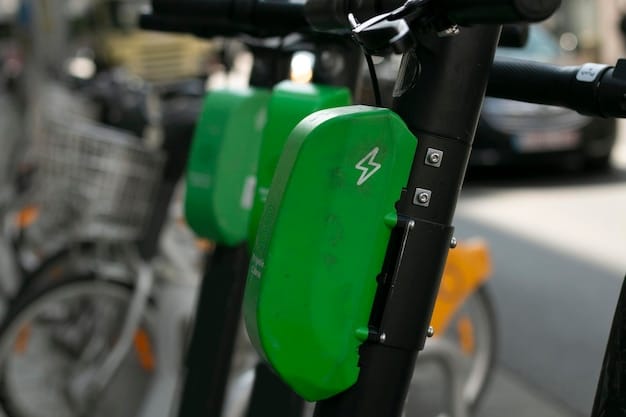How US Cities Can Prepare for 30% E-bike Growth by 2025

US cities can prepare for the expected 30% growth in e-bike usage by 2025 by investing in protected bike lanes, implementing e-bike incentive programs, updating regulations, offering safety education, and fostering community partnerships.
With the projected surge in e-bike usage on the horizon, how can US cities prepare for the expected 30% growth in e-bike usage by 2025? It’s a crucial question that demands proactive planning and strategic investment to ensure safe, efficient, and sustainable urban mobility.
Understanding the E-bike Revolution
E-bikes are transforming urban transportation. Their popularity is surging due to their convenience, affordability, and environmental benefits. As more people turn to e-bikes for commuting, recreation, and errands, cities need to adapt to accommodate this evolving landscape.
The Rise of E-bikes
E-bikes offer a compelling alternative to traditional bikes and cars. They provide motorized assistance, making cycling accessible to a wider range of individuals, including those who may struggle with hills or long distances. This increased accessibility is driving the rapid adoption of e-bikes across the US.
Benefits of Increased E-bike Usage
Increased e-bike usage brings numerous benefits to cities and their residents. These include reduced traffic congestion, lower carbon emissions, improved air quality, and enhanced public health. Embracing e-bikes can contribute to creating more livable, sustainable, and vibrant urban environments.
- Reduced traffic congestion: E-bikes can navigate crowded city streets more efficiently than cars, helping to alleviate traffic bottlenecks.
- Lower carbon emissions: E-bikes produce zero tailpipe emissions, reducing the carbon footprint of urban transportation.
- Improved air quality: By replacing car trips with e-bike rides, cities can improve air quality and reduce respiratory health issues.
- Enhanced public health: Cycling is a great form of exercise, and e-bikes make it easier for people to incorporate physical activity into their daily routines.
In conclusion, understanding the e-bike revolution is crucial for cities aiming to create sustainable and efficient urban mobility systems. By recognizing the benefits and addressing the challenges, cities can harness the full potential of e-bikes to improve the quality of life for their residents.

Infrastructure Development: Building for E-bikes
The foundation of e-bike integration lies in infrastructure. Cities must invest in safe, accessible, and well-maintained infrastructure to support e-bike ridership. This includes dedicated bike lanes, secure parking facilities, and charging stations strategically located throughout the city.
Protected Bike Lanes
Protected bike lanes are essential for ensuring the safety of e-bike riders. These lanes provide a physical separation from vehicular traffic, reducing the risk of accidents and creating a more comfortable cycling environment. Cities should prioritize the construction of protected bike lanes on high-traffic corridors and in areas with a high concentration of e-bike users.
Secure Parking Facilities
Secure parking facilities are crucial for preventing e-bike theft and encouraging ridership. These facilities can include dedicated bike lockers, attended parking garages, and publicly accessible bike racks with security features. Providing secure parking options makes e-bike ownership more appealing and reduces the risk of theft, a significant concern for many potential riders.
Charging Infrastructure
Charging infrastructure is a key component of e-bike integration. Cities should install publicly accessible charging stations in convenient locations, such as parks, libraries, transit hubs, and workplaces. These charging stations should be easy to use and compatible with a variety of e-bike models. Strategic placement of charging infrastructure can alleviate range anxiety and encourage more people to switch to e-bikes.
- Install charging stations in parks and recreational areas.
- Provide charging facilities at transit hubs and stations.
- Incentivize businesses to install charging stations for employees and customers.
To summarize, infrastructure development is crucial for accommodating the growth of e-bike usage. By investing in protected bike lanes, secure parking facilities, and charging infrastructure, cities can create a welcoming environment for e-bike riders and encourage more people to adopt this sustainable mode of transportation.
Policy and Regulation: Creating a Supportive Framework
Effective policies and regulations are vital for managing e-bike usage. Cities need to update their existing regulations to address the unique characteristics of e-bikes. This includes clarifying speed limits, defining where e-bikes can be ridden, and establishing safety standards for e-bike operation.
Updating Traffic Laws
Traffic laws need to be updated to clearly define the rules of the road for e-bikes. This includes specifying where e-bikes can be ridden, such as bike lanes, shared-use paths, and streets. It also involves setting appropriate speed limits for e-bikes and addressing issues such as helmet requirements and licensing.
Creating E-bike Incentive Programs
E-bike incentive programs can help to make e-bikes more affordable and accessible to a wider range of residents. These programs can include rebates, tax credits, and financing options. By reducing the upfront cost of e-bikes, cities can encourage more people to switch to this sustainable mode of transportation.
Establishing Safety Standards
Establishing safety standards for e-bike operation is essential for protecting riders and pedestrians. This includes requiring e-bikes to meet certain safety standards, such as having functional brakes and lights. It also involves educating riders about safe riding practices and promoting responsible e-bike usage.

In conclusion, effective policies and regulations are essential for creating a supportive framework for e-bike usage. By updating traffic laws, creating incentive programs, and establishing safety standards, cities can ensure that e-bikes are integrated safely and effectively into the urban transportation system.
Community Engagement and Education
Alongside infrastructure and policy, community engagement is key. Cities should educate the public about the benefits of e-bikes and promote safe riding practices. Community engagement initiatives can help build support for e-bike infrastructure and policies, while education programs can ensure riders are aware of the rules of the road and how to operate their e-bikes safely.
Public Awareness Campaigns
Public awareness campaigns can help to educate residents about the benefits of e-bikes and dispel any misconceptions. These campaigns can use a variety of channels, such as social media, traditional media, and community events, to reach a wide audience. By highlighting the environmental, economic, and health benefits of e-bikes, cities can encourage more people to consider switching to this sustainable mode of transportation.
E-bike Safety Workshops
E-bike safety workshops can provide riders with the knowledge and skills they need to operate their e-bikes safely. These workshops can cover topics such as proper riding techniques, traffic laws, and maintenance tips. By providing riders with the tools they need to stay safe, cities can reduce the risk of accidents and promote responsible e-bike usage.
Partnering with Local Businesses
Partnering with local businesses can help to promote e-bike usage and create a more welcoming environment for riders. Businesses can offer discounts to e-bike riders, install charging stations for customers, and sponsor e-bike-related events. By working together, cities and businesses can create a vibrant and supportive e-bike community.
- Organize community e-bike rides and events.
- Offer e-bike maintenance classes at local bike shops.
- Create a community e-bike sharing program.
In conclusion, community engagement and education are essential for creating a thriving e-bike culture. By raising public awareness, providing safety training, and partnering with local businesses, cities can foster a supportive environment for e-bike riders and encourage more people to embrace this sustainable mode of transportation.
Data Collection and Analysis
Data is paramount. Cities need to collect data on e-bike usage to inform their planning and investment decisions. This data can include ridership numbers, trip patterns, and accident rates. By analyzing this data, cities can identify areas where infrastructure improvements are needed, track the effectiveness of policies and programs, and make data-driven decisions about how to best support e-bike ridership.
Tracking E-bike Ridership
Tracking e-bike ridership is essential for understanding how e-bikes are being used and where they are being ridden. This data can be collected through a variety of methods, such as manual counts, automated sensors, and GPS tracking. By monitoring e-bike ridership, cities can identify high-traffic areas and prioritize infrastructure improvements accordingly.
Analyzing Trip Patterns
Analyzing trip patterns can provide valuable insights into how e-bikes are being used for transportation. This data can be used to identify popular routes, understand commute patterns, and assess the impact of e-bikes on traffic congestion. By understanding how e-bikes are being used for transportation, cities can develop targeted policies and programs to support e-bike ridership.
Monitoring Accident Rates
Monitoring accident rates is essential for ensuring the safety of e-bike riders. This data can be used to identify high-risk areas, track the effectiveness of safety interventions, and develop strategies to reduce accidents. By monitoring accident rates and taking proactive measures to improve safety, cities can create a safer environment for e-bike riders.
In conclusion, data collection and analysis are crucial for informing planning and investment decisions related to e-bikes. By tracking ridership, analyzing trip patterns, and monitoring accident rates, cities can make data-driven decisions about how to best support e-bike ridership and promote safe and sustainable transportation.
Funding and Resource Allocation
Financial commitment is a must. Cities need to allocate sufficient funding and resources to support e-bike infrastructure, programs, and initiatives. This includes securing funding from government grants, private partnerships, and local taxes. By allocating adequate resources, cities can demonstrate their commitment to e-bike integration and ensure that these initiatives are sustainable over the long term.
Securing Government Grants
Securing government grants is a crucial step in funding e-bike infrastructure and programs. There are a variety of federal, state, and local grants available to support sustainable transportation initiatives. Cities should actively pursue these grants and demonstrate how their e-bike initiatives align with the goals and priorities of the funding agencies.
Developing Public-Private Partnerships
Developing public-private partnerships can help to leverage private sector expertise and resources to support e-bike infrastructure and programs. These partnerships can involve private companies investing in e-bike charging infrastructure, sponsoring e-bike events, or providing e-bike sharing services. By working together, cities and private companies can create innovative and sustainable e-bike solutions.
Allocating Local Tax Revenue
Allocating local tax revenue to support e-bike initiatives can demonstrate a city’s commitment to sustainable transportation. This can involve dedicating a portion of local sales tax, property tax, or transportation tax revenue to support e-bike infrastructure, programs, and initiatives. By allocating local tax revenue, cities can create a dedicated funding source for e-bike integration and ensure that these initiatives are sustainable over the long term.
In conclusion, funding and resource allocation are essential for supporting e-bike integration. By securing government grants, developing public-private partnerships, and allocating local tax revenue, cities can ensure that they have the resources they need to create a welcoming and supportive environment for e-bike riders.
“`html
| Key Point | Brief Description |
|---|---|
| 🚲 Protected Bike Lanes | Create safe routes that separate e-bikes from car traffic. |
| 🔌 Charging Infrastructure | Install public charging stations to alleviate range anxiety. |
| 📜 Updated Regulations | Clarify e-bike rules, speed limits, and safety standards. |
| 🧑🏫 Safety Education | Offer workshops on safe riding practices and traffic laws. |
“`
[Frequently Asked Questions]
▼
E-bike adoption leads to reduced traffic congestion, lower carbon emissions, improved air quality, and enhanced public health by encouraging physical activity.
▼
Cities can secure funding through government grants, develop public-private partnerships, and allocate local tax revenue to support e-bike initiatives.
▼
Cities should establish safety standards for e-bike operation, update traffic laws, and offer safety workshops to promote responsible e-bike usage among riders.
▼
Community engagement builds support for e-bike infrastructure and policies, raises awareness about the benefits of e-bikes, and ensures riders are aware of safety practices.
▼
Cities should collect data on e-bike ridership, analyze trip patterns, and monitor accident rates to inform planning, track program effectiveness, and make data-driven decisions.
Conclusion
Preparing for the anticipated surge in e-bike usage requires a multifaceted approach encompassing infrastructure development, policy updates, community engagement, data collection, and strategic funding. By proactively addressing these key areas, US cities can harness the full potential of e-bikes to create more sustainable, equitable, and livable urban environments for all residents.
“`html





